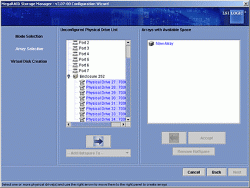

- Lsi megaraid storage manager 9.0 serial#
- Lsi megaraid storage manager 9.0 drivers#
- Lsi megaraid storage manager 9.0 upgrade#
The clear advantage of online configuration of logical volumes is shortened downtime for that server, an option 3ware’s 3DM limited online management features do not provide. Moreover, the 1210SA RAID configuration can be set not only from the BIOS utilities but also online from Adaptec’s Storage Manager browser-based GUI. The included CD boots Linux and loads a menu offering choices such as invoking a browser-based management tool, creating a diskette for the controller’s drivers, or reading the documentation. Nevertheless, the management tools are impressive. You can instruct 3DM to refuse connections from other computers, which provides a reliable, if drastic way of preventing unwanted access.Īdaptec’s recently released 1210SA controller offers only two ports, limiting the possible configurations to simple mirroring or striping over two drives. In addition, 3DM automatically schedules basic maintenance tasks such as scanning drives for errors or verifying the health status of a logical volume. A browser-contained administrative GUI, 3DM, monitors the status of the controller and automatically generates e-mail warnings of errors. Two minor annoyances: the Escalade card precedes motherboard-embedded controllers in the boot sequence, and it lacks a permanent setting for not loading the BIOS, which on my test machine meant using a key sequence at every restart to boot properly.īut all in all, I found the Escalade easy to use and configure.

Intuitive commands select drives for a new logical volume, define hot spares, and choose the striping size where appropriate. To configure the RAID level for the Escalade, you simply invoke the card’s BIOS-contained configuration utility at boot time. If your servers have enough drive slots, installing the eight-port Escalade can add terabytes of space you can easily group in multiple logical volumes, choosing the RAID architecture that best fits the application. In addition to the eight-port model I reviewed, 3ware also offers four- and 12-port versions of the controller, the latter setting a capacity record for SATA RAID cards that is unchallenged. The 3ware Escalade 8500 has already been deployed in several mid-tier storage arrays, including recent products from vendors such as Iomega and Okapi Software.
Lsi megaraid storage manager 9.0 drivers#
It’s the only controller of the three to provide drivers for Novell NetWare servers. You’ll like its powerful management tools, but don’t expect it to handle more than mirroring and striping on its two ports.Īnd finally, LSI Logic’s MegaRAID 150-4 extracts a slightly higher cost per port, but offers numerous management applications and more accurate configuration parameter tuning.
Lsi megaraid storage manager 9.0 upgrade#
For an easy and inexpensive upgrade consider the budget-friendly Adaptec 1210SA. If you’re looking for maximum storage capacity, 3ware’s Escalade provides eight ports at an attractive price and supports all major RAID levels. You also can easily add and manage large amounts of storage to your servers.īut there are important differences. Furthermore, these controllers support outstanding aggregate transfer rates, limited only by the performance capabilities of the attached drives (as verified in my tests). All three offer top-notch features and leave enterprise users with little or nothing to be desired. I recently tested SATA RAID controllers from 3ware, Adaptec, and LSI Logic, three controllers serving different sets of storage requirements. Meanwhile, SATA solutions deserve a close look.
Lsi megaraid storage manager 9.0 serial#
By contrast, the shared bus architecture of parallel SCSI is more likely to generate traffic jams in crowded configurations, a shortcoming that is being addressed in Serial Attached SCSI, a new protocol not expected to arrive in real storage products until 2004. More surprisingly, SATA solutions are also stealing points from SCSI, thanks to a slimmer protocol architecture that provides for smoother data transfers between devices and controllers. And no wonder, considering that SATA is faster, more flexible, and more scalable than ATA, not to mention equally affordable. A flurry of SATA (serial ATA) storage solutions is quickly pushing parallel ATA out of the market.


 0 kommentar(er)
0 kommentar(er)
